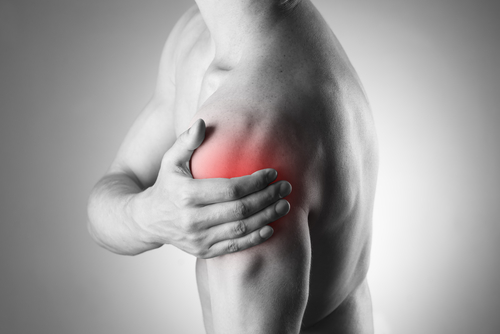
Your shoulders are one of the most versatile, complex, and overstressed joints in your body. Due to their constant use in our everyday activities, they are often prone to pain and injuries. In fact, shoulders are one of the most common sources of pain in the human anatomy. One particular study found that shoulder pain affects 18-26% of adults at any given time.
If you are experiencing shoulder pain or suffering from a shoulder injury, we encourage you to visit our board-certified, fellowship-trained orthopedic specialists at EmergeOrtho–Triangle Region. Our team is expertly skilled in identifying, treating, and managing a multitude of shoulder injuries. Our independently owned practice utilizes the most advanced medical approaches and techniques to provide patients with the best available care in the region.
As important as it is to seek care, it is just as important to seek education. Below, we delve deeper into the anatomy of the shoulder, the potential causes of injury, as well as five common shoulder injuries EmergeOrtho–Triangle Region’s specialists are experts in treating.
Elite Shoulder Care Is Found at EmergeOrtho–Triangle Region
The shoulder joint is made up of three bones: the upper arm bone (humerus), shoulder blade (scapula), and collarbone (clavicle). The head of the upper arm bone sits within a socket called a glenoid. A network of muscles and tendons (rotator cuff) cover the head of the upper arm bone and secure it within the socket. Your shoulders primarily rely on this strong network of muscles and tendons for stability, so they are often the source of pain in your shoulders (not the bones).
Shoulder injuries are commonly sustained via the following:
- Sudden Accident
- Sports Injury
- Arthritis
- Repetitive Overhead Motions
The symptoms from shoulder injuries can come on quickly or they can develop over time. Many experience minor discomfort at first, but still continue to use their shoulder as normal, hoping the pain will subside eventually. This method of ‘waiting the pain out’ can ultimately aggravate the injury, causing it to become more severe than it previously was. That is why it is crucial to have your shoulder examined as soon as you feel any symptoms.
Five Common Shoulder Injuries Expertly Treated at EmergeOrtho–Triangle Region
EmergeOrtho–Triangle Region’s talented orthopedists have successfully treated a variety of shoulder injuries over their many years of practicing. Below are five common shoulder injuries our team is highly skilled in:
- Rotator Cuff Tendonitis/Tears
The rotator cuff is made up of four muscles and their tendons. It plays an essential role in the overall health of your shoulder. It keeps your arm within the shoulder socket, and is directly related to your arm’s ability to lift and rotate. Rotator cuff tendonitis occurs when the tendons that connect the muscles are irritated and swollen. If left untreated or consistently aggravated, one or more of the tendons can tear, which causes them to fray. This is a partial tear. If the tendon tears to the point of becoming severed from the bone, it is considered a full-thickness tear. Arthritis can also develop from a tear that goes untreated for too long.  Shoulder Instability/Chronic Shoulder Instability
Shoulder Instability/Chronic Shoulder Instability
Shoulder instability occurs when the humeral head (ball) becomes dislodged from the glenoid (socket) and dislocates. The ball is normally kept centered by a complex arrangement of ligaments and muscles. The humeral head can come partially (referred to as subluxation) or completely out of the socket. Once the shoulder has dislocated, it is vulnerable to repeat episodes. When the ligaments, tendons, and muscles become frayed or loose, they may not be able to consistently keep the arm centered within the socket. This is referred to as chronic shoulder instability.- Shoulder Arthritis
Arthritis is the inflammation of one or more joints and affects more than 50 million people. There are many types of arthritis, but the two most common forms of shoulder arthritis are osteoarthritis and rheumatoid arthritis. Osteoarthritis (commonly referred to as ‘wear-and-tear’ arthritis) wears away at the articular cartilage (smooth outer covering) of the bone. Rheumatoid arthritis is a chronic, symmetrical disease that affects multiple joints in the body. It causes the synovium (the lining of your joints) to swell. Currently, all forms of arthritis are incurable, but there are various treatments that can relieve the symptoms. - Glenoid-Labrum Tear
Also known as a shoulder joint tear, this particular type of injury relates to a tear occurring at the ring of cartilage (labrum) that lines the shoulder (glenoid) socket. The labrum deepens the glenoid by 50%, allowing the much larger humeral to fit better within the socket. The labrum also provides joint stability and serves as an attachment site for many ligaments. A tear at this location can occur above or below the middle of the glenoid socket. - Frozen Shoulder (Adhesive Capsulitis)
The strong connective tissue that surrounds the shoulder joint is referred to as a shoulder capsule. In a healthy shoulder joint, synovial fluid lubricates the shoulder capsule, allowing it to move more easily. When frozen shoulder is present, the shoulder capsule thickens and becomes stiff and tight. Less synovial fluid is present, and thick bands of tissue (called adhesions) begin to form. Frozen shoulder usually develops in three stages:- Stage One-Freezing: Pain slowly worsens and there is a noticeable loss in range of motion. This can last anywhere from six weeks to nine months.
- Stage Two-Frozen: Lasting four to six months, during this stage the pain may actually improve, but the stiffness will remain.
- Stage Three-Thawing: Shoulder motion slowly begins to improve. A full return to normalcy can take anywhere from six months to two years without medical intervention.
To learn more, self-schedule an appointment now. Or, call us any time at (919) 220-5255.








